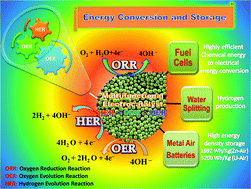Multifunctional nanostructured electrocatalysts for energy conversion and storage: current status and perspectives
Abstract
Electrocatalytic oxygen reduction reaction (ORR), oxygen evolution reaction (OER) and hydrogen evolution reaction (HER) have attracted widespread attention because of their important role in the application of various energy storage and conversion devices, such as fuel cells, metal–air batteries and water splitting devices. However, the sluggish kinetics of the HER/OER/ORR and their dependency on expensive noble metal catalysts (e.g., Pt) obstruct their large-scale application. Hence, the development of efficient and robust bifunctional or trifunctional electrocatalysts in nanodimension for both oxygen reduction/evolution and hydrogen evolution reactions is highly desired and challenging for their commercialization in renewable energy technologies. This review describes some recent developments in the discovery of bifunctional or trifunctional nanostructured catalysts with improved performances for application in rechargeable metal–air batteries and fuel cells. The role of the electronic structure and surface redox chemistry of nanocatalysts in the improvement of their performance for the ORR/OER/HER under an alkaline medium is highlighted and the associated reaction mechanisms developed in the recent literature are also summarized.

- This article is part of the themed collection: Recent Review Articles


 Please wait while we load your content...
Please wait while we load your content...